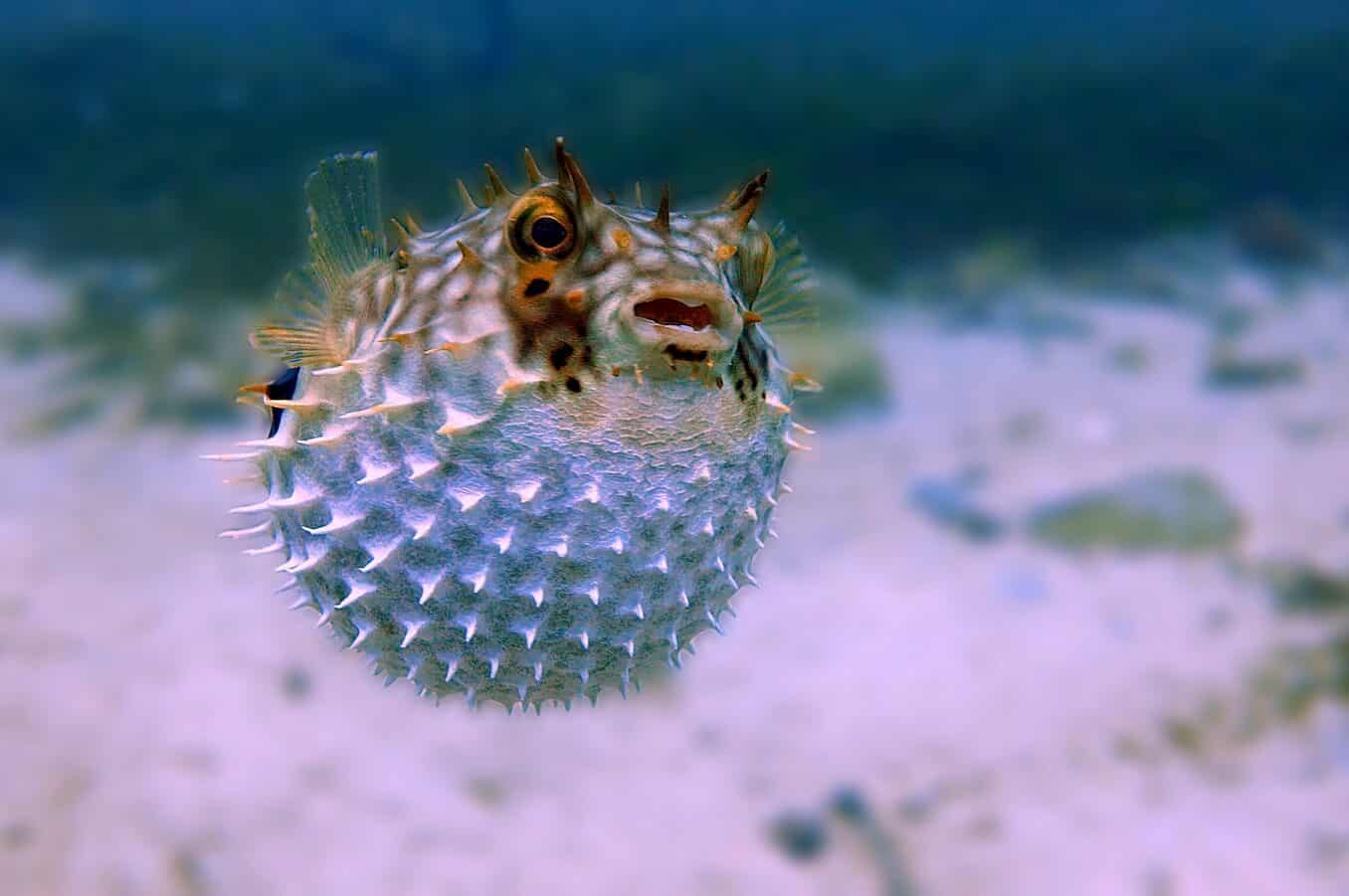
Dr. Jungle says, “One of my best friends is a puffer, I met him in a dentist office!”
� Puffers, Boxfish, and Porcupinefish are considered hardy in the sense that they will almost always adapt to aquarium food if fed proper foods. As a matter of fact… these fish love to eat. They look forward to seeing the person that feeds them like a puppy waiting for their owner to get home! Consequently they seldom starve in an aquarium, but they do have some special needs that you should be aware of in order to keep them healthy. The Puffers, Boxfish, and Porcupinefish are usually very interesting fish to observe and are quite unusual in appearance. You can see from the picture of the Black-spotted puffer above, why they are sometimes called a “dogface” puffer.
They generally move awkwardly using their pectoral fins for locomotion and the tail fin only when they need to move quickly, in the case of an emergency or newly arrived food. In captivity these fish will eat almost everything that is offered and should be fed everything like live foods (brine shrimp), algae, and frozen foods.
We are combining puffers, boxfish, and Porcupinefish because they have similar requirements and are closely related (they all belong to the same order, Tetraodontiformes, which also includes triggerfish). All of these fish, excluding the single species family, Triodontidae, are found in most of the tropical oceans of the world. Triodontidae is found only in the Indo-West Pacific.
For more Information on keeping marine fish see:
Guide to a Happy, Healthy Marine Aquarium
Puffers:
The pufferfish have a large round body with fins sticking out. They have no scales and there are four fused teeth in the jaw. The exception is the Three-toothed puffer which has only three fused teeth. They have the ability to puff themselves up with water or air if threatened. This apparently helps keep them from being eaten.
Since puffers do not have gill covers or scales, they are thought to be more susceptible to diseases, nitrite, nitrate and ammonia levels. Since they usually don’t eat all of their food, (messy eaters) these fish will usually put more load on the aquarium filtration requiring more frequent water changes and better maintenance in general.
Puffers have strong teeth that grow throughout their lives. They need to be offered hard shelled live food often to keep their teeth worn down. Acceptable foods include shellfish, crustaceans and hard shelled foods such as snails. If the teeth get too long, they will be unable to eat, requiring the owner to clip the teeth.
Though a well fed puffer will generally not eat corals they may occasionally munch on them. Also because their diet consists of meaty foods which put a large load on the bio-filter, they are not generally recommended for the reef aquarium.
There are only a few freshwater species of puffers, most puffers are a marine fish. Some species produce toxic substances that are poisonous if eaten. There are usually several deaths reported in Japan each year from eating puffers which are not prepared properly. Most of the aquarium puffers come from the genus Canthigaster.
Boxfish:
Boxfish includes the ever popular Cowfish and the Trunkfishes. The body is enclosed in a bony carapace with fins sticking out. They have no spiny dorsal fin. They move so slow that they can easily be caught by hand!
Note: Some species are dangerous to other fish (and themselves) in an aquarium. If they are threatened or become overly stressed, they can exude a toxic substance that will kill everything in the aquarium.
Even so, they are very interesting fish to keep. One fish, the Long-horned cowfish, Lactoria cornutus, has become very popular. Also, keep in mind that if one of these fish die in the aquarium remove it immediately to minimize the possibility of toxins being released.
Porcupinefish:
The Porcupinefish are similar to puffers except the body is covered with spines. In some species the spines are permanently erect like the Striped Burrfish, Chilomycterus schoepfi, in others like the Porcupine Puffer, the spines are controlled by the fish and become erect when the fish is threatened.
Featured Image Credit: Stelio Puccinelli, Unsplash








